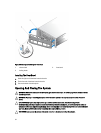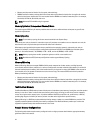
Memory bus operating frequency can be 1066 MT/s, 1333 MT/s, and 1600 MT/s depending on:
• DIMM type (RDIMM and LRDIMM)
• DIMM configuration (number of ranks)
• Maximum frequency of the DIMMs
• Number of DIMMs populated per channel
• DIMM operating voltage
• System profile selected (for example, Performance Optimized, Custom, or Dense Configuration Optimized)
• Maximum supported DIMM frequency of the processors
The system memory contain 96 memory sockets organized into eight memory risers, split into four sets of two risers per
processor. Each memory riser has:
• 12 DIMM sockets arranged into four channels. In each channel, the release levers of the first socket are marked
white, the second socket black, and the third socket green.
• Two Scalable Memory Interconnect-2 (SMI-2) ports that help DIMMs to connect with the processor.
• Two Scalable Memory Buffers (SMB) that provide access to the DIMMs.
SMI-2 ports operate in two modes:
NOTE: GT/s indicates memory bus speed in Giga transfers per second.
• Performance Mode (2:1) up to 2.66 GT/s for higher bandwidth.
• Lock Step Mode (1:1) up to 1.33 GT/s for higher DDR3 speeds and better RAS (Reliability, Availability, and
Serviceability) features.
The maximum memory that is supported on your system varies according to the sizes of memory modules being used.
Single, dual, quad, and octal-rank DIMMs of sizes 4 GB and 8 GB. The system also supports 16 GB RDIMM and 32 GB/64
GB of LRDIMMs memory for a total of up to 6 TB.
NOTE: DIMMs in memory risers A and B are assigned to processor 1, C and D are assigned to processor 2, E and F
are assigned to processor 3 and G and H are assigned to processor 4.
40


















